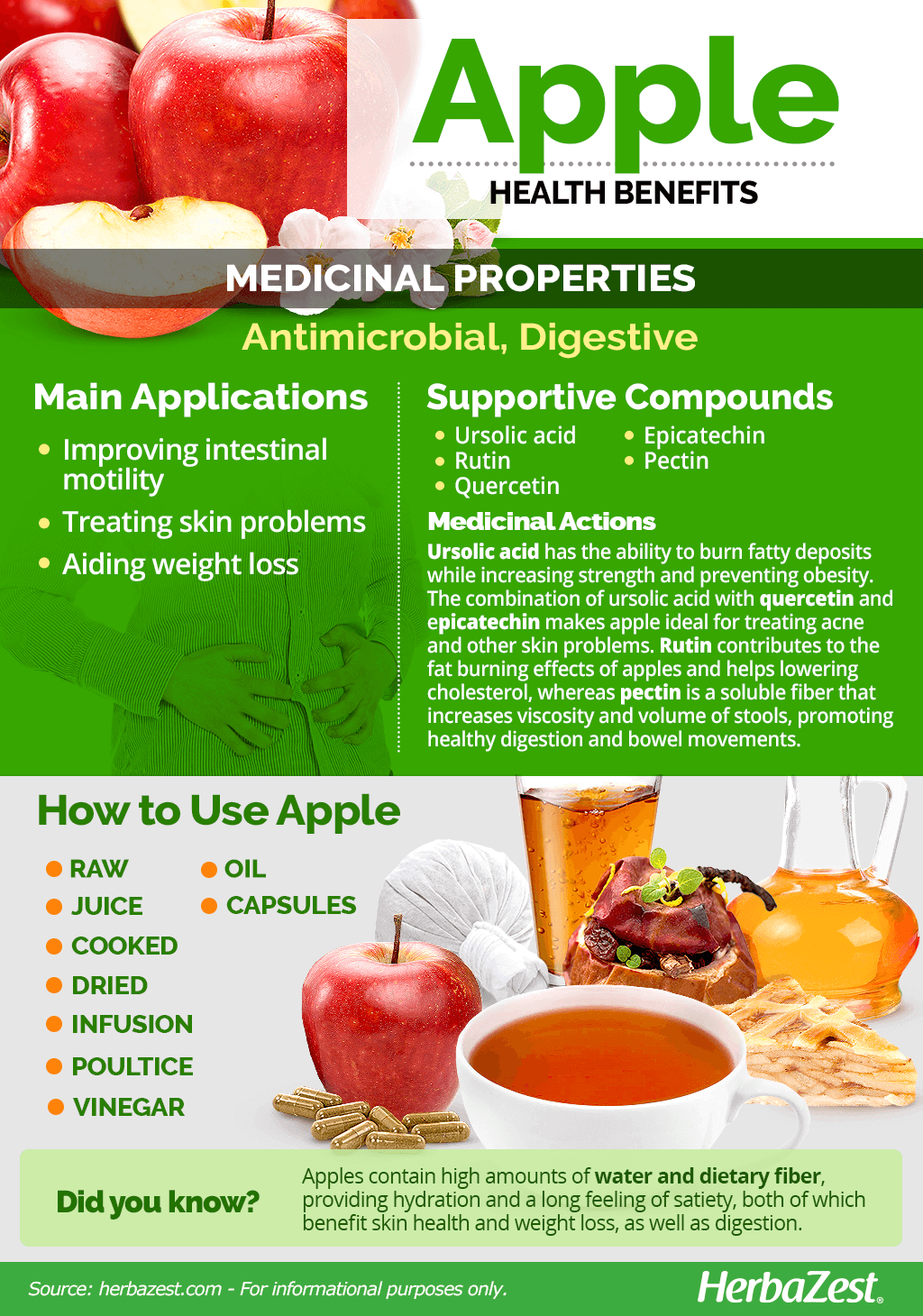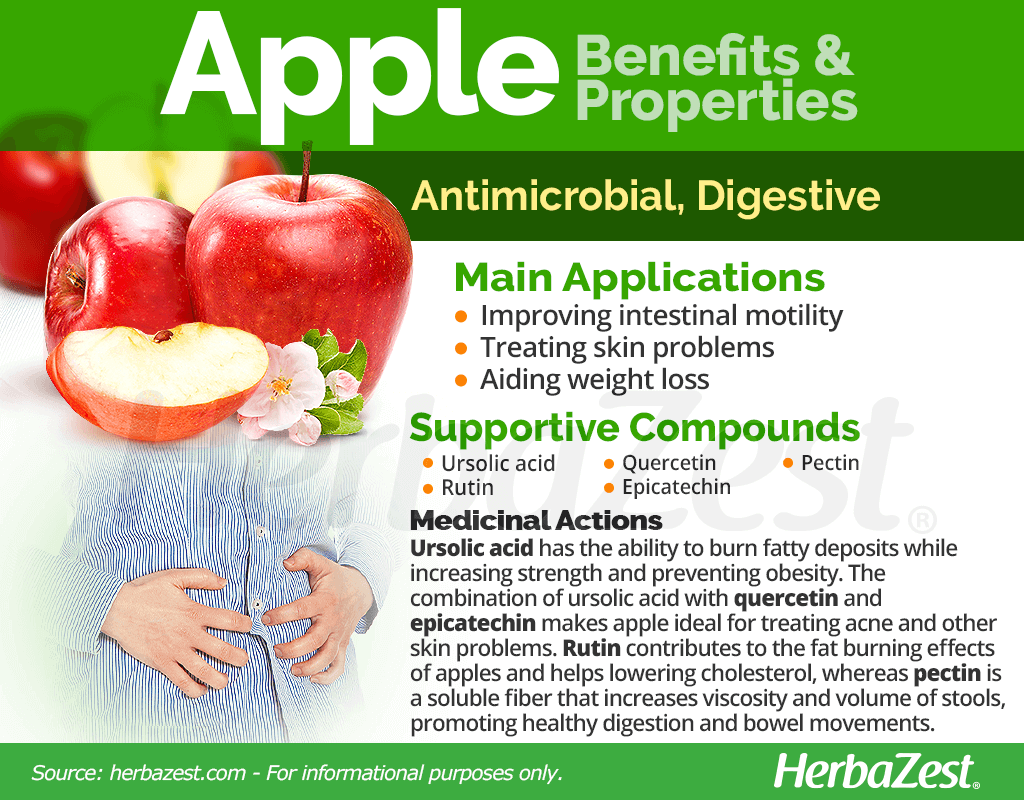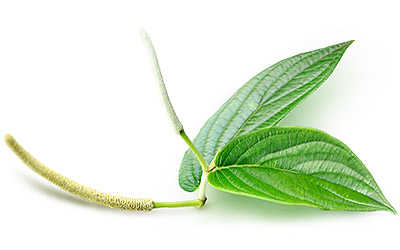Everyone's heard the saying, "An apple a day keeps the doctor away," but not many know why it continues gaining popularity throughout the years. Dating back as far as 6500 BCE, apples have continued to provide consumers worldwide a myriad of nutritional and medicinal benefits.
Apple Medicinal Properties
- Medicinal action Antimicrobial, Digestive
- Key constituents Ursolic acid, epicatechin, pectin, quercetin, rutin
- Ways to use Capsules, Hot infusions/tisanes, Food, Juiced, Poultice, Essential oil, Dried
- Medicinal rating (5) Great value
- Safety ranking Safe
Health Benefits of Apple
Throughout the many centuries of their use, apples have been used to improve human health in many different ways:
Improving intestinal motility. Apple's high fiber content helps normalize bowel movements, improving intestinal functions.
Treating skin problems. Apple seed oil has traditionally been used for treating skin lesions and acne.
Aiding weight loss. Apples are made up mostly of water, so they have a low caloric value, which makes them a smart option for weight control.
- Promoting cardiovascular health. Studies have found that eating flavonoid-rich apples can improve endothelial function, which helps decrease the risk of developing heart disease.1
It has also been discovered that daily apple vinegar consumption may help control blood sugar and reduce oxidative stress in diabetics with high cholesterol.2
Additionally, a study has shown that supplementation of apples' polyphenols can improve skin pigmentation caused by UV irradiation by protecting against oxidative stress.3
As for nutritional value, apples contain dietary fiber, vitamins C, B2 (riboflavin), magnesium, and potassium, as well as both simple and complex sugars.
How It Works
Apple peel contains ursolic acid, which has been found to possess astringent, anti-parasitic, and antiseptic properties. The combination of ursolic acid with the antioxidant, antimicrobial actions of the flavonols quercetin and epicatechin makes of apple a great ally against skin lesions and acne.
Emerging research is linking ursolic acid to the ability to turn white adipose tissue - the normal fatty deposits carried under the skin - into brown adipose tissue, a special type of fat that is burned by the body to generate heat. This brown fat also shares origins with skeletal muscle. Increased consumption in ursolic acid leads to increased strength and endurance, ultimately helping prevent obesity.
Rutin is a glycoside derived from quercetin, and share the same antioxidant, vasodilating and cardioprotective properties. Rutin has also been shown to have hypolipidemic effects, which contribute to the well-known cholesterol lowering and fat burning effects of apples.
Apples are also a good source of pectin, a type of soluble fiber that is contained mostly in the seeds of the fruit and helps improve digestion. Pectin aids with both diarrhea and constipation by regulating the viscosity and volume of stools.
Most medicinal benefits of apple are concentrated in the peel and the seeds of the fruit.
Other herbs that possess antibacterial properties are calendula and Oregon grape, and similar digestive benefits can be found in papaya and pineapple.
Apple Side Effects
While apples are healthy fruits, people with birch-pollen allergies can develop an allergy to apples because of similarity in proteins. This syndrome - referred to as birch-apple syndrome- usually occurs up to 15 minutes after consumption of a raw apple and includes oral reactions, such as an itchy throat and inflammation.
The amount of allergen in the raw fruit depends on the variety, maturity, and storage conditions. Seed medical attention immediately is there is suspicion of an allergic reaction while eating raw apples or taking apple cider vinegar.
Apple Cautions
Consuming apple juice can interfere with the effectiveness of some prescription drugs, such as antihistamines and cardiovascular medications. This is due to substances in apple juice blocking the action of transporters that help move a drug into cells for absorption.
Read medication labels for specific instructions on what to avoid. And if still uncertain, consult a trusted health physician about fruit juice consumption with medications.
Apple Nutrition
The nutritional value of apple is based in its high amounts of water and dietary fiber, which provide hydration and a long feeling of satiety, two great apple benefits for skin health and weight loss, as well as for the digestive system.
Apple's nutrition is rounded by fair amounts of vitamin C (ascorbic acid) as well as by small quantities of important minerals, such as copper, potassium, manganese, magnesium, phosphorus, calcium, iron, and zinc, along with vitamins, including most of the B complex, choline, vitamin A (as carotenoids), and vitamin K (phylloquinone).
100 grams of an average apple provides 52 calories, 85.5 grams of water, 8%DV of complex carbohydrates and 10%DV of dietary fiber.

How to Consume Apple
- Edible parts Fruit
- Edible uses Beverage
- Taste Sweet, Tart
Equal parts sweet, tart, and crunchy, apple is an extremely popular food source around the world and, for many, steadily fulfills part of the daily fruit requirement. The health benefits of apples can be obtained just by adding the apple fruit into a regular and balanced diet. However, for medicinal purposes, apple can be prepared in concentrated forms for a variety of preparations.
Natural Forms
Raw. Eating an apple fruit per day is enough to reap most of its nutritional benefits, including fiber, vitamins and minerals.
Juice. Apple juice is rich in antioxidant compounds and it is thought to be good for brain function, as well as for skin and cardiovascular health. However care should be taken with the high sugar content of some commercial brands.
Dried. Sliced or in small pieces, dehydrated apple is a great snack between meals, since it is fiber-rich and full of antioxidant phenols.
Cooked. Apples are also used as an ingredient in larger dishes, from sandwiches to dinner entrees to various baked goods.
Infusion. An infusion made from apple bark or leaves is thought to help settle upset stomachs, heartburn, and reflux due to its astringent nature. It is also believed to help calm diarrhea or address chronic loose stool. Swishing the infusion around in the mouth may help tone weak and easily bleeding gums.
Poultice. Apple leaves are believed to help with inflamed swellings, boils, bug bites, and scratches as a chewed, topical application.
Herbal Remedies & Supplements
Vinegar. The benefits of apple cider vinegar include weight loss, lowering blood sugar and cholesterol, and even balancing the pH of the skin.
Oil. Apple seed oil is rich in essential fatty acids (mainly linoleic acid) and phenolic compounds. It can be useful for treating acne as well as dry, itchy skin.
Capsules. Apple cider vinegar pills boast the same benefits as consuming apples by helping improve digestion to promote weight loss. Pectin supplements are also used for diabetes and acid reflux.
Growing
- Life cycle Perennial
- Harvested parts Fruit
- Light requirements Full sun
- Soil Well-drained
- Soil pH 6.1 – 6.5 (Slightly acidic), 6.6 – 7.3 (Neutral)
- Growing habitat Cool temperate regions, Temperate climates
- Planting time Fall
- Propagation techniques Stem cuttings
Apples are deciduous trees that have adapted to temperate climates with relative seasonal change. Growing this fruit in a backyard orchard is a useful addition for any home gardener.
Growing Guidelines
- Apple trees are usually propagated by grafting. However, apple seeds can be planted in the autumn for late winter germination.
- Apple trees grow best in deep, well-drained, loamy soil with pH of 6 - 7, in a sunny location.
- Approximately 1,000 hours of winter temperatures below 44°F (7°C) incite flower development later on.
- The trees require adequate rainfall - 23 - 31 inches (600 - 800 mm) annually - to ensure future fruiting as well.
- Seeds may take 12 months or more to sprout and several subsequent years to produce fruit. For home growing, it is generally recommended to buy young apple trees from a local nursery.
- Apples must be unhooked, not pulled, from the attachment point when harvested. Bruising from improper picking methods with reduce quality grade and increase storage losses.
- Control pest problems before they become worse by cutting dead or diseased branches, removing dried apples, and clearing leaves and fallen debris away from the trees.
More detailed information about growing apples can be found in the herb garden section.
Additional Information
- Other uses Alcohol, Cosmetics, Furniture/carpentry
Plant Biology
The apple tree stands approximately 30 feet (9 m) tall and has a spreading canopy of elliptical leaves during warmer months. Its flowers, which bloom in the spring, are white with red-pink undersides and give way to a fruit classified as a pome, where the fleshy bulk actually derives from the flower cup. Each fruit contains approximately five small seeds.
Classification
The apple tree (Malus domestica) is one of over 2,800 species belonging to the Rosaceae family, which notably includes apricot (Prunus armeniaca), cherry (Prunus spp.), hawthorn (Crataegus monogyna), pear (Pyrus communis), agrimony (Agrimonia eupatoria), and blackberry (Rubus fruticosus). Apple is one of the up to 55 species of Malus that grow in the Northern Hemisphere, though it alone is the most commonly consumed.
Varieties and Subspecies of Apple
A hybrid species, the domestic apple is itself a subspecies of several others. It is thought that two of the major contributing parent species were Malus sieversii, a central Asian strain, and the wild European crabapple, Malus sylvestris.
M. domestica comes in over 7,500 different varieties today. Some of the most popular commercial types include 'Red Delicious' and 'Fuji' apples, which are particularly sweet; 'Granny Smith' apples, which are tarter; and 'McIntosh' apples, considered best for baking, among other varieties.
Historical Information
The first edible apple varieties are believed to be native to eastern Jordan and date back as far as 6500 BCE, but the exact origins of the fruit as we know it today are less clear. It is thought that the genus Malus, meaning "evil" after the biblical story of Genesis, is a hybrid of many different wild species ranging from Asia to Western Europe, actively cultivated throughout temperate climates on the Eurasian continent since at least 323 BCE.
Apples eventually became a staple food across the Mediterranean region and were incorporated into religious lore by the ancient Greeks, Romans, and Hebrews. It remained one of the quintessential symbols of the autumn harvest throughout the Middle Ages. British settlers first brought the tree to North America in the 1600s, where it became so popular as to develop into a cultural symbol for the United States.
Economic Data
Apples are the second most consumed fruit, and global production was estimated at over 67 million metric tons in 2012 alone. China generates the vast majority of production, contributing with 38 million metric tons, with the U.S. as a second largest producer. Apple cultivation is also a major economic activity in the European Union, Turkey, and Chile.
Apples are also one of the most valuable fruit crops in the United States; every state grows them with Washington leading production at 70%. Other leading states include New York, California, Virginia, and Pennsylvania.
Other Uses
Food industry. Many industries have used apple to their advantage over the years, particularly for its high concentration of pectin, which is often used as a thickening agent. Commercial jams and jellies are known to include this substance.
Timber. Apple tree wood has been employed in the past as fuel and construction material for canes and furniture.
Cosmetics. Apple extracts are used for their astringent and antioxidant benefits to rejuvenate the skin and help with anti-aging efforts on different skin types. It can be found in personal care products such as oils, extracts, salves, and creams.
Beverages. Apples are used in the making of many traditional liquors, like calvados and apple sour, as well as in apple wine and apple cider (with and without alcohol).
Apples are recognized worldwide for their delicious, varying tastes and textures, as well as for their many uses outside of the kitchen. However, their medicinal benefits for improving skin tone and controlling weight, among others, are adding value to their increasing popularity as one of the healthiest fruits.
Sources
- Apple Cider Vinegar Benefits & Cures
- Clinical Nutrition Journal, Apple phytochemicals and their health benefits, 2004
- Molecules, Variability in Catechin and Rutin Contents and Their Antioxidant Potential in Diverse Apple Genotypes, 2019
- North Carolina State University, Growing Apple Trees in the Home Garden
- Oregon State University, About the Apple - Malus domestica
- Public Library of Science Genet, New Insight into the History of Domesticated Apple: Secondary Contribution of the European Wild Apple to the Genome of Cultivated Varieties, 2012
- The Korean Journal of Physiology & Pharmacology, Ursolic acid in health and disease, 2018
- University of Georgia, Apple - Malus domestica
- FAOSTAT, Apples
- USDA Nutrient Database, National Nutrient Database for Standard Reference - Full Report (All Nutrients): 09003, Apples, raw, with skin
- Public Library of Science One, Ursolic Acid Increases Skeletal Muscle and Brown Fat and Decreases Diet-Induced Obesity, Glucose Intolerance and Fatty Liver Disease, 2012
- Nutrition Journal, Apple Phytochemicals and their Health Benefits, 2004
Footnotes:
- Molecular Nutrition & Food Research. (2017). Flavonoid-Rich Apple Improves Endothelial Function in Individuals at Risk for Cardiovascular Disease: A Randomized Controlled Clinical Trial. Retrieved November 11, 2020 from https://pubmed.ncbi.nlm.nih.gov/29086478/
- Clinical Nutrition ESPEN. (2019). The effect of apple vinegar consumption on glycemic indices, blood pressure, oxidative stress, and homocysteine in patients with type 2 diabetes and dyslipidemia: A randomized controlled clinical trial. Retrieved November 11, 2020 from https://pubmed.ncbi.nlm.nih.gov/31451249/
- Nutrients. (2020). Administration of Apple Polyphenol Supplements for Skin Conditions in Healthy Women: A Randomized, Double-Blind, Placebo-Controlled Clinical Trial. Retrieved November 11, 2020 from https://www.mdpi.com/2072-6643/12/4/1071
















